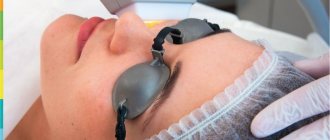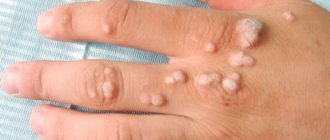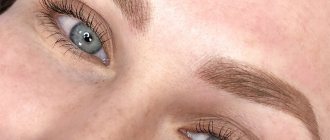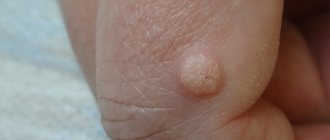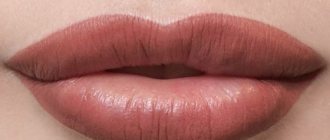Lasers are used in many areas of surgery, including the removal of skin tumors. Laser destruction has become an effective and reliable way to get rid of a tumor, without the risk of relapse of the disease and severe pain. Thanks to the targeted action, the laser beam acts selectively, namely on tumor cells, without affecting healthy tissue.
Warts, or nevi as they are called, are a cluster of pigmented cells that can be located on any part of the body and mucous membranes.
What is the essence of the method?
A directed laser beam increases the temperature in tissue cells and causes their destruction, resulting in tissue necrosis and death. The doctor can adjust the wavelength and degree of impact, so the laser action is directed only at the tissue of the formation, without affecting or injuring healthy tissue. Due to the high temperature, nearby vessels coagulate and the risk of bleeding is minimal. After the procedure, a small wound remains, then a crust forms, which disappears after a week on its own.
In what cases should you consult a doctor again?
When serous or purulent discharge, odor, redness, pain appear from the wound - such situations can occasionally occur within 7 days. You need to see a doctor about this. After the examination, the doctor will give recommendations for further care.
After the first month, when the scar has formed, it is most often normotrophic - neat and already similar to the color of the skin. But sometimes a trophic, hypertrophic or keloid scar can form. Such a scar can be corrected by a surgeon or contact a cosmetologist who can also help with this.
+7 (495) 255−50−11.
Preparation for the procedure
Before laser removal, a thorough examination and examination of the tumor is carried out to ensure its benign nature. If the tumor contains malignant cells, the laser cannot be used. Wart removal will be carried out using a classic operation with removal of the tumor and part of the healthy tissue. Laser surgery is not performed if during the operation it is necessary to take biological material for subsequent research.
In addition to examining the mole, the doctor surveys the patient about possible contraindications to the procedure, and also conducts a number of studies (blood tests).
What research is done before removing skin tumors?
The main optical device used by a dermatologist to examine moles and other skin growths before their removal is a dermatoscope. A dermatoscope consists of a magnifying lens and a light source to improve the visibility of subsurface structures of the skin.
The examination procedure using a dermatoscope is called dermatoscopy. This diagnostic method allows an experienced specialist to visually assess and diagnose the nature of a skin tumor under tens of times magnification.
Post-procedure care
For a quick and complete recovery, high-quality postoperative care is necessary.
- The wound after surgery should not come into contact with water for at least 2-3 days.
- Do not remove the crust that has formed (it will fall off on its own).
- Treat the wound with an antiseptic.
- Protect the manipulation site from injury.
- Wounds and new skin formed must be protected from ultraviolet radiation.
- The surgical area should not be shaved or epilated until complete healing.
After surgical removal of the formation
When the formation is removed using a scalpel, an incision is made and a cosmetic suture is applied; in this case, no special care is required either. Usually we stick on strips, under which the wound heals itself and you come to us on the seventh day to remove the stitches. If you get these strips wet, it is advisable to dry them and treat them with an alcohol solution or chlorhexidine.
If the wound after removal is large or located on the scalp, we treat such places with either iodine solution, betadine, or fucorcin so that a secondary infection does not join the wound.
Benefits of laser wart removal
Laser removal has many advantages:
- High quality result. During surgery, the tumor is completely removed, there is no risk of relapse.
- Pain and discomfort are minimal or absent. The procedure is performed under local anesthesia.
- Speed of the procedure. Laser destruction of a wart takes no more than 5 minutes.
- Minimally traumatic procedure. The laser beam acts only on the cells of the formation, without affecting nearby tissues.
- Excellent cosmetic effect. After laser removal there are no scars or marks left.
- Versatility. Due to the precision of the laser, this method can be used on any part of the body, including areas with thin and sensitive skin, mucous membranes, intimate area, eyelid skin, etc.
- There is no rehabilitation period. The procedure is performed on an outpatient basis, after which you can lead your normal lifestyle.
- Minimal risk of postoperative bleeding. The action of the laser coagulates blood vessels, which eliminates the risk of bleeding.
Prices:
Prices for removal of formations
| Consultation with a dermato-oncologist surgeon | FOR FREE |
| Dermatoscopy: | |
| - for all education | 500 rub. |
| Skin mapping: | |
| 1-3 formations | 500 rub. |
| 4-10 formations | 2,000 rub. |
| 11-25 formations | 4,000 rub. |
| 26-50 formations | 6,000 rub. |
| Histological examination: | |
| Histology Dialab | 1,500 rub. |
| Histology Hemotest | 3,000 rub. |
| Revision of glasses by expert morphologist Prof. Mordovtseva V.V. | 6,000 rub. |
| Local anesthesia: | |
| - injection | 300 rub. |
| - cream | 300 rub. |
| Laser removal of 1 formation on the skin: | |
| diameter: | |
| - up to 1 mm | 100 rub. |
| - up to 2 mm | 400 rub. |
| - up to 3 mm | 600 rub. |
| - up to 4 mm | 700 rub. |
| — up to 5 mm | 800 rub. |
| - up to 6 mm | 900 rub. |
| - up to 7 mm | 1,000 rub. |
| - up to 8 mm | 1,100 rub. |
| - up to 9 mm | 1,200 rub. |
| - up to 10 mm | 1,300 rub. |
| Laser removal of 1 formation on the skin of the eyelids, mucous membranes, plantar and periungual: | |
| - up to 1 mm | 300 rub. |
| - up to 2 mm | 400 rub. |
| - up to 3 mm | 700 rub. |
| - up to 4 mm | 800 rub. |
| — up to 5 mm | 900 rub. |
| - up to 6 mm | 1,000 rub. |
| - up to 7 mm | 1,100 rub. |
| - up to 8 mm | 1,200 rub. |
| - up to 9 mm | 1,300 rub. |
| - up to 10 mm | 1,400 rub. |
| Chalazion removal | 7,000 rub. |
| Laser removal of 1 formation on the ciliary edge of the eyelids: | |
| - up to 1 mm | 500 rub. |
| - up to 2 mm | 1,000 rub. |
| - up to 3 mm | 1,500 rub. |
| - up to 4 mm | 2,000 rub. |
| — up to 5 mm | 2,500 rub. |
| Excision of formations with suturing: | |
| Excision of formations with 5 mm sutures on the body | 1,500 rub. |
| Excision of formations with sutures on the face M-zone (cheeks, forehead, chin, temple, scalp) - 5 mm | 2,500 rub. |
| Excision of formations with sutures on the face H-zone (nose, eyelids, lips, ears) - 5 mm | 5,000 rub. |
| Excision of formations with 5 mm sutures on the hands and feet | 2,500 rub. |
| Excision of formations using the Mohs method + cost of wound closure: | 30,000 rub. |
| on the face M-zone (cheeks, forehead, chin, temple, scalp) - 5 mm | 2,500 rub. |
| on the face H-zone (nose, eyelids, lips, ears) - 5 mm | 5,000 rub. |
| Removal of molluscum contagiosum in children under 10 years of age: | |
| - for one education | 300 rub. |
| Laser correction of ingrown toenails (one side of the nail): | |
| Laser correction with removal of the growth zone | 3,500 rub. |
| Resection of an ingrown nail without removing the growth zone | 1,900 rub. |
| Removing the thumbnail | 1,700 rub. |
| Removal of the nail on the 2nd to 5th finger | 1,000 rub. |
| Earlobe correction: | |
| — After earrings (for 1 side) | 3,000-6,000 rub. |
| — Correction of the shape of the lobes, including tunnels (for 1 side) | 10,000 rub. |
| Excision of scars (per 1 cm incision): | |
| Excision of scars on the body, 1 cm of scar | 3,000 rub. |
| Excision of scars on the face and neck, 1 cm of scar | 5,000 rub. |
| Correction of body scar with local tissues, 1 cm of scar | 5,000 rub. |
| Correction of face and neck scars with local tissues, 1 cm of scar | 10,000 rub. |
| Correction of retracted scars with Collost filler 7% - 1.5 ml | 13,000 rub. |
| Correction of retracted scars with Collost filler 15% - 1.5 ml | 18,000 rub. |
| Spherogel Lights 0.5 ml | 6,000 rub. |
| Spherogel Lights 1.0 ml | 11,000 rub. |
| Spherogel Medium 0.5 ml | 8,000 rub. |
| Spherogel Medium 1.0 ml | 15,000 rub. |
| Scar hormone therapy (Diprospan) | 1,300 rub. |
| Laser resurfacing CO2 1 cm2 | 2,000 rub. |
| Biopolymer removal | 40,000 rub. |
Contraindications for laser removal
Laser procedures are not performed under the following conditions:
- oncological diseases of any localization;
- HIV, MSID, viral hepatitis, diabetes mellitus;
- pregnancy and lactation;
- exacerbation of chronic diseases;
- infectious or inflammatory diseases;
- mental disorders;
- severe damage to the heart and lungs;
- organ failure;
- bleeding disorders;
- skin photosensitivity;
- autoimmune systemic diseases;
- inflammatory skin diseases, exacerbation of herpes infection.
If you need to diagnose or remove a wart, contact a medical professional. The operations are carried out at a high professional level using modern laser technology of the latest generation, which eliminates the risk of complications or relapse. Laser removal of warts is carried out at any convenient time on an outpatient basis, which will not affect your usual lifestyle. You can make an appointment by calling the center or leaving a request on the website.
What is the best method for removing skin tumors?
Our clinic's arsenal includes almost all methods for removing any benign skin tumors, except for surgical and chemical destruction: laser removal, radio wave removal - radiosurgery, diathermocoagulation - plasma coagulation and cryodestruction - removal with liquid nitrogen.
In each individual case, the question of choosing a removal method depends on the nature of the tumor, its size, location, and concomitant pathologies. Therefore, the concept of the best removal method simply does not exist.
Equipment
In the case of laser removal of plantar warts, a special medical laser device is used that emits rays that are absorbed by water or blood in the tissues. Thanks to this specific absorption, water quickly evaporates from the tissues, they dry out with minimal blood loss. In case of removal of plantar warts using the radio wave method, appropriate devices (Surgitron or other brands) are used. In them, electromagnetic radiation with a very high frequency evenly and bloodlessly separates tissues without burning them.
How can a tumor be removed without leaving a trace on the skin?
All superficial neoplasms - papillomas, keratomas, etc., as well as small formations, are most often removed without scars or marks on the skin. After removal of large formations, traces of hypopigmentation or barely noticeable whitish scars may remain.
In any case, it is very important when removing! clearly assess the line separating the difference between the aesthetic result of the procedure and its effectiveness. This means that the wider and deeper the tumor is removed, the lower the likelihood of relapse. Conversely, minimal superficial removal is always an ideal cosmetic result, rapid epithelization, absence of a scar, but a high risk of developing recurrent neoplasm at this site. The experience of our doctors, mandatory diagnostics and the availability of a wide range of equipment allow our specialists to maintain a competent balance between removing the tumor in full and obtaining the best possible cosmetic result of the procedure.
Self-medication is harmful
Do not try to diagnose and treat HPV infection on your own! Firstly, there is a risk of improper use of drugs. Secondly, only a doctor can distinguish papilloma from a malignant tumor. In addition, self-treatment is fraught with consequences.
Today, there are celandine-based preparations on sale that are intended to eliminate warts. Celandine juice is similar in composition to iodine. Therefore, prolonged exposure to the drug causes skin burns. In this case, papillomas are seriously injured and can provoke the development of skin cancer. Cauterization with iodine is even more dangerous - it is more aggressive than celandine. Trying hard to get rid of papillomas with iodine, you can get scars on the skin. Vinegar is no better in this regard. Attempts to bandage warts and papillomas with a thin silk thread often only provoke the growth of these formations.
If you suspect the appearance of warts or genital warts, you should definitely seek advice from a dermatologist, urologist or gynecologist, depending on the location of the source of infection. Only a professional can correctly diagnose the disease and prescribe the necessary treatment.


